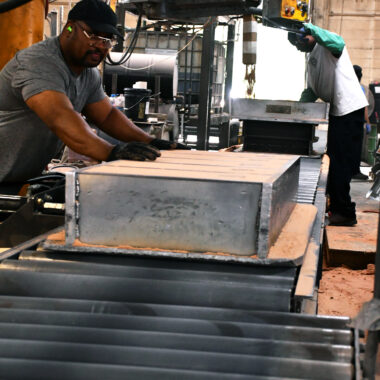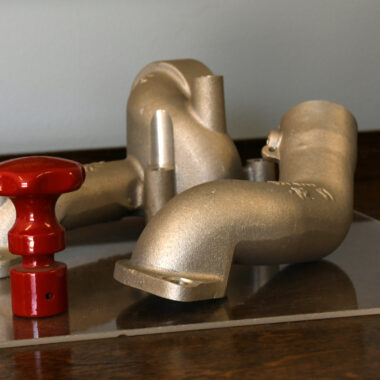About Aluminum Casting Essentials: Everything You Need to Know
About Aluminum Casting Essentials: Everything You Need to Know
Blog Article
Crafting Excellence: How to Achieve High-Quality Aluminum Castings Every Time
In the realm of light weight aluminum casting, the quest of excellence is a continual journey that needs a meticulous method and an eager understanding of the details involved. Accomplishing regular top quality aluminum spreadings requires a thorough grasp of the processes, from choosing the proper alloy to executing precise mold styles and thoroughly regulating spreading specifications.
Understanding Aluminum Casting Processes
Aluminum casting processes, vital in the production sector, entail the detailed makeover of liquified aluminum into solid forms through a series of carefully controlled steps. Understanding these processes is paramount to achieving top quality aluminum spreadings continually - about aluminum casting. The key approaches used in aluminum casting are die spreading, sand casting, and financial investment casting

Each of these procedures has its advantages and is picked based upon aspects like intricacy, quantity, and preferred coating of the aluminum casting. about aluminum casting. Recognizing the complexities of these techniques is critical for suppliers intending to generate high-grade light weight aluminum spreadings continually
Picking the Right Aluminum Alloy
Selecting the proper aluminum alloy is an important decision in the production of high-quality light weight aluminum spreadings. When choosing a light weight aluminum alloy for spreading, it is crucial to think about the specific demands of the application to make certain optimal efficiency.
Among the most frequently used aluminum alloys for spreading is A356. This alloy offers outstanding castability, high toughness, and good rust resistance, making it ideal for a vast array of applications. Alternatively, 6061 light weight aluminum alloy is favored for its exceptional weldability and excellent mechanical homes. For applications needing high stamina, 7075 light weight aluminum alloy is a preferred choice because of its phenomenal strength-to-weight ratio.
Along with mechanical homes, factors to consider such as expense, accessibility, and post-casting procedures must additionally affect the option of the appropriate light weight aluminum alloy. By meticulously reviewing these variables, suppliers can make certain the manufacturing of high-grade light weight aluminum spreadings that satisfy the preferred specs.
Executing Proper Mold Layout
Creating a reliable mold design is essential for ensuring the effective production of high-grade light weight aluminum castings. Proper mold and mildew style plays a significant role in attaining the preferred qualities of the end product. To execute a successful mold and mildew style, factors such as product circulation, cooling rates, and part geometry have to be carefully thought about.
One key element of mold style is guaranteeing correct dental filling and solidification of the aluminum within the mold and mildew cavity. This entails creating runner and gating systems that promote smooth metal circulation and avoid defects such as air entrapment or insufficient dental filling. Furthermore, incorporating cooling networks into the mold and mildew design aids control solidification prices and reduce the danger of porosity or shrinkage flaws.

Controlling Casting Parameters

Ensuring Post-Casting High Quality Checks
To maintain the high quality of aluminum spreadings, detailed post-casting quality checks are vital. After the spreading procedure is finished, it is critical to ensure that the final products meet the preferred criteria and requirements.
Dimensional precision is an additional critical aspect that should be confirmed during post-casting high quality checks. Measurements of vital dimensions and tolerances should be required to confirm that the spreadings adjust to the called for specs. In addition, mechanical residential or commercial properties such as firmness, tensile stamina, and effect resistance may need to be evaluated through product screening to make sure that the castings possess the necessary strength and durability for their intended application.
Verdict
Finally, attaining top notch aluminum castings calls for a thorough understanding of the spreading procedures, choosing the appropriate alloy, designing mold and mildews successfully, controlling spreading criteria carefully, and conducting post-casting high quality checks diligently. By following these steps, makers can regularly create aluminum spreadings that meet the highest standards of high quality and performance.
Accomplishing constant high-quality aluminum castings requires continue reading this a comprehensive understanding of the procedures, from choosing the proper alloy to executing precise mold and mildew styles and diligently regulating casting parameters. The main techniques utilized in aluminum spreading are pass away casting, sand spreading, and financial investment spreading.
Financial investment spreading, also known as accuracy casting, involves producing wax patterns that are covered in ceramic to form molds.Choosing the proper light weight aluminum alloy is a vital decision in the manufacturing of premium light weight aluminum spreadings.Making certain accurate control over spreading parameters is important for keeping uniformity and quality in aluminum spreading manufacturing.
Report this page